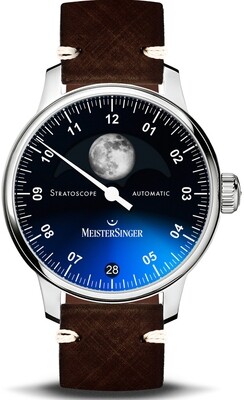The Astroscope displays the days of the week in a unique way, i.e., related to the celestial bodies that have been assigned to the weekdays since ancient times. Monday, the Moon ☽ Tuesday, Mars ♂ Wednesday, Mercury ☿ Thursday, Jupiter ♃ Friday, Venus ♀ Saturday, Saturn ♄ Sunday, the Sun ☉ A yellow dot indicates the current day of the week, not in a linear or radial fashion, but wandering back and forth in a constellation that only occurs every ten to twelve years in the southern night sky of the northern hemisphere. The Astroscope has received the German Design Award, the Red Dot Design Award, and the iF Design Award for its overall design concept. Only 200 pieces of this version have been manufactured.
The Astroscope features a black dial with yellow contrasts and an intimated horizon, which gives the impression of a night sky. In the upper half of the dial, arranged in a semicircle are the symbols of the seven planets, which have been linked to the days of the week since ancient times. A yellow dot shows the current day of the week. The bezel of the circular date window above the 6 o’clock position is yellow and highly polished.
The slender stainless steel case is 40 mm in diameter, its elegant lines are water-resistant up to 5 bar, and a domed sapphire glass covers the dial. The movement can be easily viewed through the sixfold screwed glass exhibition back as it performs its high-precision task. The imprint “One of 200” on the glass exhibition back emphasizes the fact that this watch is one of only 200 pieces manufactured.
The Swiss Sellita SW220 automatic movement, which is specially modified for MeisterSinger’s single-hand watches, quietly ticks inside the Astroscope. Concealed by the dial, a large weekday ring with several white dots advances one step day by day. A clearly visible white dot tells the wearer the current day of the week. The date display can be conveniently set via its quick-switch function. The rotor provides the watch with a power reserve of 38 hours.






